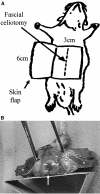The prevention of incisional hernia formation using a delayed-release polymer of basic fibroblast growth factor
- PMID: 15213634
- PMCID: PMC1356390
- DOI: 10.1097/01.sla.0000131576.12153.ab
The prevention of incisional hernia formation using a delayed-release polymer of basic fibroblast growth factor
Abstract
Objective: We sought to reduce the high incidence of abdominal wall incisional hernias using sustained release growth factor therapy.
Summary background data: Incisional hernias complicate 11% of abdominal wall closures, resulting in 200,000 incisional hernia repairs in the United States each year. Mechanical improvements alone in mesh, suture material, and surgical technique have failed to reduce the high rate of fascial wound failure.
Methods: Sprague-Dawley rats underwent midline celiotomies that were closed with fast-absorbing suture to induce early biomechanical wound failure and incisional hernia formation. In primary wounds, fascial incisions were closed adjacent to a continuous release polygalactone polymer rod containing basic fibroblast growth factor (bFGF), no growth factor (control-rod), or without rods. In a second group, incisional hernias were repaired with either bFGF or control-rod therapy. Breaking strength was measured on postoperative day (POD) 7, and the incidence of incisional hernia formation was determined on POD 28.
Results: Treatment with bFGF rods significantly increased fascial wound breaking strength. In the "hernia-prevention" experiments, incisional hernias developed in 90% of untreated incisions, 60% of control-rod incisions, and only 30% of bFGF-rod incisions (P < 0.05). In the "hernia-treatment" experiments, recurrent incisional hernias developed in 86% of control-rod incisions compared with only 23% of bFGF-rod treated incisions (P < 0.05). Immunohistochemistry demonstrated increased angiogenesis and collagen protein production in bFGF treated incisions.
Conclusion: The treatment of abdominal fascial incisions with a sustained-release bFGF polymer significantly lowered the incidence of incisional hernias and the recurrence rate after repair.
Figures





Similar articles
-
Transforming growth factor beta(2) lowers the incidence of incisional hernias.J Surg Res. 2001 May 15;97(2):109-16. doi: 10.1006/jsre.2001.6083. J Surg Res. 2001. PMID: 11341785
-
Effect of cytokine growth factors on the prevention of acute wound failure.Wound Repair Regen. 2004 Jan-Feb;12(1):38-43. doi: 10.1111/j.1067-1927.2004.012109.x. Wound Repair Regen. 2004. PMID: 14974963
-
Mesh incisional herniorrhaphy increases abdominal wall elastic properties: a mechanism for decreased hernia recurrences in comparison with suture repair.Surgery. 2006 Jul;140(1):14-24. doi: 10.1016/j.surg.2006.01.007. Surgery. 2006. PMID: 16857438
-
Updated guideline for closure of abdominal wall incisions from the European and American Hernia Societies.Br J Surg. 2022 Nov 22;109(12):1239-1250. doi: 10.1093/bjs/znac302. Br J Surg. 2022. PMID: 36026550 Free PMC article.
-
Prevention of incisional hernias: how to close a midline incision.Surg Clin North Am. 2013 Oct;93(5):1027-40. doi: 10.1016/j.suc.2013.06.009. Surg Clin North Am. 2013. PMID: 24035074 Review.
Cited by
-
Tissue integration and inflammatory reaction in full-thickness abdominal wall repair using an innovative composite mesh.Hernia. 2016 Aug;20(4):607-22. doi: 10.1007/s10029-015-1383-4. Epub 2015 Apr 23. Hernia. 2016. PMID: 25903676
-
The use of amnion-derived cellular cytokine solution to improve healing in acute and chronic wound models.Eplasty. 2008 Apr 11;8:e21. Eplasty. 2008. PMID: 18470282 Free PMC article.
-
Transvaginal repair of a large chronic porcine ventral hernia with synthetic mesh using NOTES.JSLS. 2010 Apr-Jun;14(2):234-9. doi: 10.4293/108680810X12785289144313. JSLS. 2010. PMID: 20932375 Free PMC article.
-
Bench-to-bedside review: Routine postoperative use of the nasogastric tube - utility or futility?Crit Care. 2007;11(1):201. doi: 10.1186/cc5118. Crit Care. 2007. PMID: 17214909 Free PMC article. Review.
-
Amnion-derived multipotent progenitor cells increase gain of incisional breaking strength and decrease incidence and severity of acute wound failure.J Burns Wounds. 2007 Oct 5;7:e5. J Burns Wounds. 2007. PMID: 18091982 Free PMC article.
References
-
- Santora TA, Rosylyn JJ. Incisional hernia: hernia surgery. Surg Clin North Am. 1993;73:557–570. - PubMed
-
- Mudge M, Hughers LE. Incisional hernia: a 10 year prospective study. Br J Surg. 1985;72:70–71. - PubMed
-
- Carlson MA. Acute wound failure. Wound healing. Surg Clin North Am. 2001;77:607–635. - PubMed
-
- National Health Statistics Center. Detailed diagnose & procedures. National hospital discharge survey 1995;12(122). - PubMed
-
- Wedbush Morgan Securities. Biotechnology in wound care 2001;4:1–82.
Publication types
MeSH terms
Substances
LinkOut - more resources
Full Text Sources
Other Literature Sources
Medical

